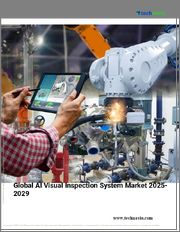
|
시장보고서
상품코드
1721245
세계의 자동 광학 검사 시스템 시장 조사 보고서 : 산업 분석, 규모, 점유율, 성장, 동향, 예측(2025-2033년)Global Automated Optical Inspection System Market Research Report- Industry Analysis, Size, Share, Growth, Trends and Forecast 2025 to 2033 |
||||||
세계의 자동 광학 검사 시스템 시장 규모는 2024년 19억 달러에서 2033년에는 104억 1,000만 달러로 성장하며, 2026-2033년의 예측 기간 중 20.81%의 견고한 연평균 성장률(CAGR)을 보일 것으로 예측됩니다.
자동 광학 검사 시스템 시장은 산업계가 제조 공정에서 품질관리와 결함 검출을 점점 더 우선시함에 따라 상당한 성장이 예상됩니다. 이러한 시스템은 첨단 영상 기술과 인공지능을 활용하여 제품을 고속으로 검사하고 엄격한 품질 기준을 충족하는 제품만 시장에 출시할 수 있도록 합니다. 세계 경쟁이 치열해짐에 따라 제조업체들은 낭비와 생산 비용을 최소화하면서 고품질의 생산물을 유지하는 것이 중요하다는 것을 인식하고 있습니다. 자동 광학 검사 시스템에 대한 수요는 기업이 업무 효율성을 높이고 비용이 많이 드는 리콜과 반품의 위험을 줄이려고 노력함에 따라 급증할 것으로 예측됩니다.
또한 머신러닝과 데이터 분석을 자동 광학 검사 시스템에 통합하는 것은 품질관리 수행 방식에 혁명을 일으키고 있습니다. 이러한 기술을 통해 시스템은 과거 검사를 통해 학습하고 시간이 지남에 따라 정확도와 적응성을 향상시킬 수 있습니다. 전자, 자동차, 제약 등의 산업에서 이러한 시스템의 도입이 증가함에 따라 시장에서는 특정 용도에 맞는 혁신적인 솔루션이 급증할 것으로 예측됩니다. 생산 공정에 대한 실시간 피드백과 인사이트를 제공하는 능력은 자동 광학 검사 시스템의 가치를 더욱 높여 현대 제조업에 필수적인 툴로 자리매김하고 있습니다.
지속가능성과 자원 효율성에 대한 관심이 높아짐에 따라 자동 광학 검사 시스템 시장도 이러한 과제에 대응하기 위해 진화하고 있습니다. 이러한 시스템은 낭비를 줄이고 고품질 제품만을 생산함으로써 보다 지속가능한 제조 방식에 기여하고 있습니다. 또한 다양한 산업 분야에서 규제 준수 및 안전 표준에 대한 중요성이 높아지면서 자동 검사 솔루션의 채택이 증가하고 있습니다. 이 시장의 미래는 지속적인 기술 혁신, 기능 강화 및 품질에 대한 노력으로 특징지어지며, 자동 광학 검사 시스템이 전 세계 제조 공정의 발전에 중요한 역할을 할 수 있도록 하고 있습니다.
목차
제1장 서문
제2장 개요
- 시장의 하이라이트
- 세계 시장 스냅숏
제3장 자동 광학 검사 시스템 : 산업 분석
- 서론 : 시장 역학
- 시장 성장 촉진요인
- 시장 성장 억제요인
- 시장 기회
- 업계 동향
- Porter's Five Forces 분석
- 시장의 매력 분석
제4장 밸류체인 분석
- 밸류체인 분석
- 원재료 분석
- 원재료 리스트
- 원재료 제조업체 리스트
- 주요 원재료의 가격 동향
- 잠재적 바이어 리스트
- 마케팅 채널
- 다이렉트 마케팅
- 인다이렉트 마케팅
- 마케팅 채널 발전 동향
제5장 세계의 자동 광학 검사 시스템 시장 분석 : 유형별
- 개요 : 유형별
- 유형별, 실적 및 예측 데이터 분석
- 2D AOI
- 3D AOI
제6장 세계의 자동 광학 검사 시스템 시장 분석 : 기술별
- 개요 : 기술별
- 기술별, 실적 및 예측 데이터 분석
- 인라인
- 오프라인
제7장 세계의 자동 광학 검사 시스템 시장 분석 : 최종 용도별
- 개요 : 최종 용도별
- 최종 용도별, 실적 및 예측 데이터 분석
- IT & 통신
- CE(Consumer Electronics)
- 자동차
- 산업용 일렉트로닉스
- 항공우주·방위
- 의료
- 기타
제8장 세계의 자동 광학 검사 시스템 시장 분석 : 지역별
- 지역별 전망
- 서론
- 북미의 판매 분석
- 개요, 실적과 예측
- 북미 : 부문별
- 북미 : 국가별
- 미국
- 캐나다
- 멕시코
- 유럽의 판매 분석
- 개요, 실적과 예측
- 유럽 : 부문별
- 유럽 : 국가별
- 영국
- 프랑스
- 독일
- 이탈리아
- 러시아
- 기타 유럽
- 아시아태평양의 판매 분석
- 개요, 실적과 예측
- 아시아태평양 : 부문별
- 아시아태평양 : 국가별
- 중국
- 인도
- 일본
- 한국
- 호주
- 동남아시아
- 기타 아시아태평양
- 라틴아메리카의 판매 분석
- 개요, 실적과 예측
- 라틴아메리카 : 부문별
- 라틴아메리카 : 국가별
- 브라질
- 아르헨티나
- 페루
- 칠레
- 기타 라틴아메리카
- 중동 및 아프리카의 판매 분석
- 개요, 실적과 예측
- 중동 및 아프리카 : 부문별
- 중동 및 아프리카 : 국가별
- 사우디아라비아
- 아랍에미리트
- 이스라엘
- 남아프리카공화국
- 기타 중동 및 아프리카
제9장 자동 광학 검사 시스템 기업의 경쟁 구도
- 자동 광학 검사 시스템 시장 경쟁
- 제휴·협력·합의
- 합병·인수
- 신제품 발표
- 기타 개발
제10장 기업 개요
- 상위 기업의 시장 점유율 분석
- 시장 집중도
- Maxim SMT Pvt. Ltd.
- Daiichi Jitsugyo Asia Pte. Ltd.
- GA트카 Pel Electronic GmbH.
- Koh Young Technology Inc.
- Mirtec Co. Ltd.
- Nordson Corporation
- Omron Corporation
- Saki Corporation
- Test Research Inc.
- Viscom SE
Global Automated Optical Inspection System Market size is anticipated to grow from USD 1.9 Billion in 2024 to USD 10.41 Billion by 2033, showcasing a robust Compound Annual Growth Rate (CAGR) of 20.81% during the forecast period of 2026 to 2033.
The automated optical inspection system market is set for substantial growth as industries increasingly prioritize quality control and defect detection in manufacturing processes. These systems utilize advanced imaging technologies and artificial intelligence to inspect products at high speeds, ensuring that only items meeting stringent quality standards reach the market. As global competition intensifies, manufacturers are recognizing the importance of maintaining high-quality outputs while minimizing waste and production costs. The demand for automated optical inspection systems is expected to surge as companies seek to enhance their operational efficiency and reduce the risk of costly recalls or rework.
Moreover, the integration of machine learning and data analytics into automated optical inspection systems is revolutionizing the way quality control is conducted. These technologies enable systems to learn from previous inspections, improving their accuracy and adaptability over time. As industries such as electronics, automotive, and pharmaceuticals increasingly adopt these systems, the market is likely to witness a proliferation of innovative solutions tailored to specific applications. The ability to provide real-time feedback and insights into production processes further enhances the value of automated optical inspection systems, making them indispensable tools for modern manufacturing.
As the focus on sustainability and resource efficiency grows, the automated optical inspection system market is also evolving to meet these challenges. By reducing waste and ensuring that only high-quality products are produced, these systems contribute to more sustainable manufacturing practices. Additionally, the increasing emphasis on regulatory compliance and safety standards across various industries is driving the adoption of automated inspection solutions. The future of this market is characterized by continuous innovation, enhanced capabilities, and a commitment to quality, ensuring that automated optical inspection systems play a vital role in the evolution of manufacturing processes worldwide.
Our reports are meticulously crafted to provide clients with comprehensive and actionable insights into various industries and markets. Each report encompasses several critical components to ensure a thorough understanding of the market landscape:
Market Overview: A detailed introduction to the market, including definitions, classifications, and an overview of the industry's current state.
Market Dynamics: In-depth analysis of key drivers, restraints, opportunities, and challenges influencing market growth. This section examines factors such as technological advancements, regulatory changes, and emerging trends.
Segmentation Analysis: Breakdown of the market into distinct segments based on criteria like product type, application, end-user, and geography. This analysis highlights the performance and potential of each segment.
Competitive Landscape: Comprehensive assessment of major market players, including their market share, product portfolio, strategic initiatives, and financial performance. This section provides insights into the competitive dynamics and key strategies adopted by leading companies.
Market Forecast: Projections of market size and growth trends over a specified period, based on historical data and current market conditions. This includes quantitative analyses and graphical representations to illustrate future market trajectories.
Regional Analysis: Evaluation of market performance across different geographical regions, identifying key markets and regional trends. This helps in understanding regional market dynamics and opportunities.
Emerging Trends and Opportunities: Identification of current and emerging market trends, technological innovations, and potential areas for investment. This section offers insights into future market developments and growth prospects.
SEGMENTATION COVERED IN THE REPORT
By Type
- 2D AOI
- 3D AOI
By Technology
- Inline
- Offline
By End Use
- IT & Telecom
- Consumer Electronics
- Automotive
- Industrial Electronics
- Aerospace & Defense
- Medical
- Others
- COMPANIES PROFILED
- Maxim SMT Pvt. Ltd.
- Daiichi Jitsugyo Asia Pte. Ltd.
- Gopel electronic GmbH.
- Koh Young Technology Inc.
- Mirtec Co. Ltd.
- Nordson Corporation
- Omron Corporation
- Saki Corporation
- Test Research Inc.
- Viscom SE
- The above list can be customized.
TABLE OF CONTENTS
1. PREFACE
- 1.1. Report Description
- 1.1.1 Objective
- 1.1.2 Target Audience
- 1.1.3 Unique Selling Proposition (USP) & offerings
- 1.2. Research Scope
- 1.3. Research Methodology
- 1.3.1 Market Research Process
- 1.3.2 Market Research Methodology
2. EXECUTIVE SUMMARY
- 2.1. Highlights of Market
- 2.2. Global Market Snapshot
3. AUTOMATED OPTICAL INSPECTION SYSTEM INDUSTRY ANALYSIS
- 3.1. Introduction - Market Dynamics
- 3.2. Market Drivers
- 3.3. Market Restraints
- 3.4. Opportunities
- 3.5. Industry Trends
- 3.6. Poerter's Five Force Analysis
- 3.7. Market Attractiveness Analysis
- 3.7.1 Market Attractiveness Analysis By Type
- 3.7.2 Market Attractiveness Analysis By Technology
- 3.7.3 Market Attractiveness Analysis By End Use
- 3.7.4 Market Attractiveness Analysis By Region
4. VALUE CHAIN ANALYSIS
- 4.1. Value Chain Analysis
- 4.2. Raw Material Analysis
- 4.2.1 List of Raw Materials
- 4.2.2 Raw Material Manufactures List
- 4.2.3 Price Trend of Key Raw Materials
- 4.3. List of Potential Buyers
- 4.4. Marketing Channel
- 4.4.1 Direct Marketing
- 4.4.2 Indirect Marketing
- 4.4.3 Marketing Channel Development Trend
5. GLOBAL AUTOMATED OPTICAL INSPECTION SYSTEM MARKET ANALYSIS BY TYPE
- 5.1. Overview By Type
- 5.2. Historical and Forecast Data Analysis By Type
- 5.3. 2D AOI Historic and Forecast Sales By Regions
- 5.4. 3D AOI Historic and Forecast Sales By Regions
6. GLOBAL AUTOMATED OPTICAL INSPECTION SYSTEM MARKET ANALYSIS BY TECHNOLOGY
- 6.1. Overview By Technology
- 6.2. Historical and Forecast Data Analysis By Technology
- 6.3. Inline Historic and Forecast Sales By Regions
- 6.4. Offline Historic and Forecast Sales By Regions
7. GLOBAL AUTOMATED OPTICAL INSPECTION SYSTEM MARKET ANALYSIS BY END USE
- 7.1. Overview By End Use
- 7.2. Historical and Forecast Data Analysis By End Use
- 7.3. IT & Telecom Historic and Forecast Sales By Regions
- 7.4. Consumer Electronics Historic and Forecast Sales By Regions
- 7.5. Automotive Historic and Forecast Sales By Regions
- 7.6. Industrial Electronics Historic and Forecast Sales By Regions
- 7.7. Aerospace & Defense Historic and Forecast Sales By Regions
- 7.8. Medical Historic and Forecast Sales By Regions
- 7.9. Others Historic and Forecast Sales By Regions
8. GLOBAL AUTOMATED OPTICAL INSPECTION SYSTEM MARKET ANALYSIS BY GEOGRAPHY
- 8.1. Regional Outlook
- 8.2. Introduction
- 8.3. North America Sales Analysis
- 8.3.1 Overview, Historic and Forecast Data Sales Analysis
- 8.3.2 North America By Segment Sales Analysis
- 8.3.3 North America By Country Sales Analysis
- 8.3.4 United States Sales Analysis
- 8.3.5 Canada Sales Analysis
- 8.3.6 Mexico Sales Analysis
- 8.4. Europe Sales Analysis
- 8.4.1 Overview, Historic and Forecast Data Sales Analysis
- 8.4.2 Europe By Segment Sales Analysis
- 8.4.3 Europe By Country Sales Analysis
- 8.4.4 United Kingdom Sales Analysis
- 8.4.5 France Sales Analysis
- 8.4.6 Germany Sales Analysis
- 8.4.7 Italy Sales Analysis
- 8.4.8 Russia Sales Analysis
- 8.4.9 Rest Of Europe Sales Analysis
- 8.5. Asia Pacific Sales Analysis
- 8.5.1 Overview, Historic and Forecast Data Sales Analysis
- 8.5.2 Asia Pacific By Segment Sales Analysis
- 8.5.3 Asia Pacific By Country Sales Analysis
- 8.5.4 China Sales Analysis
- 8.5.5 India Sales Analysis
- 8.5.6 Japan Sales Analysis
- 8.5.7 South Korea Sales Analysis
- 8.5.8 Australia Sales Analysis
- 8.5.9 South East Asia Sales Analysis
- 8.5.10 Rest Of Asia Pacific Sales Analysis
- 8.6. Latin America Sales Analysis
- 8.6.1 Overview, Historic and Forecast Data Sales Analysis
- 8.6.2 Latin America By Segment Sales Analysis
- 8.6.3 Latin America By Country Sales Analysis
- 8.6.4 Brazil Sales Analysis
- 8.6.5 Argentina Sales Analysis
- 8.6.6 Peru Sales Analysis
- 8.6.7 Chile Sales Analysis
- 8.6.8 Rest of Latin America Sales Analysis
- 8.7. Middle East & Africa Sales Analysis
- 8.7.1 Overview, Historic and Forecast Data Sales Analysis
- 8.7.2 Middle East & Africa By Segment Sales Analysis
- 8.7.3 Middle East & Africa By Country Sales Analysis
- 8.7.4 Saudi Arabia Sales Analysis
- 8.7.5 UAE Sales Analysis
- 8.7.6 Israel Sales Analysis
- 8.7.7 South Africa Sales Analysis
- 8.7.8 Rest Of Middle East And Africa Sales Analysis
9. COMPETITIVE LANDSCAPE OF THE AUTOMATED OPTICAL INSPECTION SYSTEM COMPANIES
- 9.1. Automated Optical Inspection System Market Competition
- 9.2. Partnership/Collaboration/Agreement
- 9.3. Merger And Acquisitions
- 9.4. New Product Launch
- 9.5. Other Developments
10. COMPANY PROFILES OF AUTOMATED OPTICAL INSPECTION SYSTEM INDUSTRY
- 10.1. Top Companies Market Share Analysis
- 10.2. Market Concentration Rate
- 10.3. Maxim SMT Pvt. Ltd.
- 10.3.1 Company Overview
- 10.3.2 Company Revenue
- 10.3.3 Products
- 10.3.4 Recent Developments
- 10.4. Daiichi Jitsugyo Asia Pte. Ltd.
- 10.4.1 Company Overview
- 10.4.2 Company Revenue
- 10.4.3 Products
- 10.4.4 Recent Developments
- 10.5. GA¶Pel Electronic GmbH.
- 10.5.1 Company Overview
- 10.5.2 Company Revenue
- 10.5.3 Products
- 10.5.4 Recent Developments
- 10.6. Koh Young Technology Inc.
- 10.6.1 Company Overview
- 10.6.2 Company Revenue
- 10.6.3 Products
- 10.6.4 Recent Developments
- 10.7. Mirtec Co. Ltd.
- 10.7.1 Company Overview
- 10.7.2 Company Revenue
- 10.7.3 Products
- 10.7.4 Recent Developments
- 10.8. Nordson Corporation
- 10.8.1 Company Overview
- 10.8.2 Company Revenue
- 10.8.3 Products
- 10.8.4 Recent Developments
- 10.9. Omron Corporation
- 10.9.1 Company Overview
- 10.9.2 Company Revenue
- 10.9.3 Products
- 10.9.4 Recent Developments
- 10.10. Saki Corporation
- 10.10.1 Company Overview
- 10.10.2 Company Revenue
- 10.10.3 Products
- 10.10.4 Recent Developments
- 10.11. Test Research Inc.
- 10.11.1 Company Overview
- 10.11.2 Company Revenue
- 10.11.3 Products
- 10.11.4 Recent Developments
- 10.12. Viscom SE
- 10.12.1 Company Overview
- 10.12.2 Company Revenue
- 10.12.3 Products
- 10.12.4 Recent Developments



















